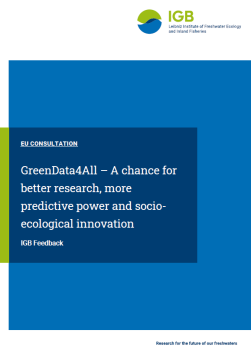
Aquatic ecosystems are intrinsically complex because they have a network structure and nonlinear processes often take place at various spatial and temporal scales. Nonlinear reactions can occur, for example, as a result of perturbations that trigger a so-called regime shift, such as prolonged drought. Important determinants of complex aquatic ecosystems are the landscape structure in which the water bodies are located and the connectivity, i.e. the interconnection of the water bodies at different levels: These include the flows of water, energy, information, nutrients and pollutants, and the dispersal of organisms. These processes determine the structure and dynamics of ecosystems and are changed over time by external factors such as land use and climate change.
In the programme area “Dimensions of complexity of aquatic systems”, IGB aims to gain a better understanding of the dynamics and functioning of aquatic systems and the living organisms within them. Its overall goal is to enhance our mechanistic understanding on how freshwater ecosystems function and to study their spatial and temporal scaling. An important focus is on the interfaces and interactions between terrestrial and aquatic habitats, between sediment and the water column, between water and air, and between and within organisms.
Speakers
News
Downloads
Selected publications
Sub-daily stable water isotope dynamics of urban tree xylem water and ambient vapor
The authors combined in situ monitoring of stable isotopes and ecohydrological monitoring in different urban vegetation in Berlin. They provide novel insights on plant physiology and hydrological functioning through high-resolution isotope data to capture sub-daily plant water uptake and internal water cycling.

A tiered complexity conceptual framework for treating water soluble, hydrophilic contaminants in green stormwater infrastructure
Blue-green infrastructure is a critical tool for improving stormwater quality, but the removal of dissolved, hydrophilic contaminants remains a major challenge. The authors propose a tiered conceptual framework of progressively more complex, costly, and resource-intensive interventions to remove dissolved, hydrophilic contaminants and thus minimize risks to ecosystems and drinking water sources.
Hydrological Processes in Lowlands and Plains
Lowlands and plains provide important ecosystem services such as agricultural and forestry production, groundwater recharge, streamflow generation and drinking water supply. This Special Issue collects scientific papers advancing understanding of the mechanisms underlying the movement and storage of water in lowland and plain environments.
Knots in the Strings: Do Small-Scale River Features Shape Catchment-Scale Fluxes?
The authors review how river “knots” associated with bifurcations, confluences, and obstructions, which are spatially and temporally heterogeneous reaches in a river network affect reach-scale processes including flow attenuation, enhanced vertical and lateral connectivity, and augmented solute retention and uptake. .
Stepwise tracer-based hydrograph separation to quantify contributions of multiple sources of streamflow in a large glacierized catchment over the Tibetan Plateau
The authors identified the sources of streamflow and their temporal dynamics in a glacierized catchment of the Tibetan Plateau using isotopic and geochemical signatures. They demonstrated that incorporation of high-resolution tracer data in an appropriate model structure can help resolve streamflow components and identify the dynamics of dominant recharge sources in cryosphere environments.































